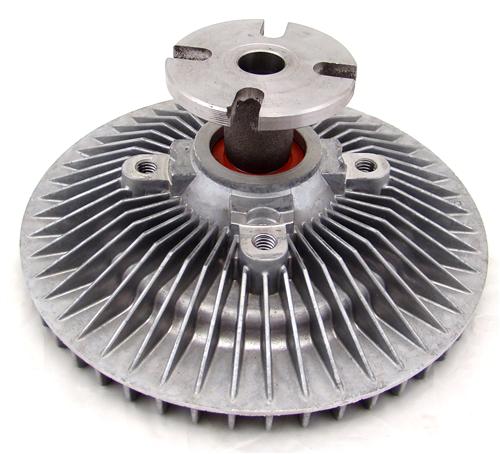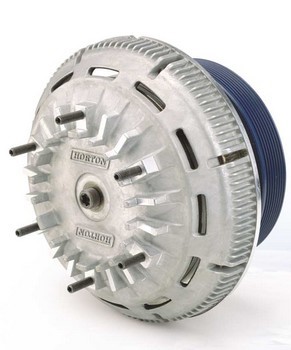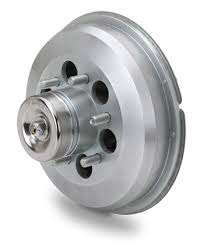What Does Fan Clutches Do?
Table of ContentsOur Fan Clutches DiariesFan Clutches for DummiesHow Fan Clutches can Save You Time, Stress, and Money.Excitement About Fan Clutches
Engine fan with thick drive A fan clutch is a thermostatic engine cooling fan that can freewheel at low temperature levels when cooling is not needed, allowing the engine to heat up much faster, eliminating unneeded load on the engine. As temperatures increase, the clutch engages so that the fan is driven by engine power and moves air to cool the engine.This conserves power, given that the engine does not need to fully drive the fan. Nevertheless, if engine temperature level rises above the clutch's engagement temperature level setting, the fan becomes fully engaged, therefore drawing a higher volume of ambient air through the vehicle's radiator, which in turn serves to preserve or reduce the engine coolant temperature level to an acceptable level.
This is easier to accomplish because the engine is mounted longitudinally, with the belt device elements mounted dealing with the radiator. The fan is mounted on the crankshaft wheel or among the accessory pulley-blocks (e. g. the water pump wheel) and will spin in between the radiator and the engine, drawing air back through the radiator and blowing it over the engine.
In contrast, in a front-wheel drive lorry, the engine is typically mounted laterally, with the crankshaft and generally all the major accessory shafts parallel to the front axle, so regarding directly drive the transaxle; a fan mechanically mounted on an accessory sheave would blow sideways and would not face the radiator.
The conversion of power to electrical energy and back to mechanical rotary power with a fan motor is less efficient than a direct mechanical connection, but this is more than compensated by greater control of an electric fan through electronic thermostatic controls which can turn the fan completely off when the engine temperature is below the setpoint.
Fan Clutches Fundamentals Explained
Some clutches are electronically managed (instead of bi-metallic strip). These supply the potential to control the level of engagement depending upon any number of inputs. Typical managing factors may consist of engine oil temperature, transmission oil temperature level, coolant temperature level, Air Conditioner system pressures and ambient air temperature level.
When you think about a vehicle cooling system, the very first thing that likely comes to mind is your radiatoror possibly your cooling fan. The oft-overlooked doesn't get a lots of credit or attention, however it's a necessary piece of the cooling equation in lots of lorries. It helps your cooling system run successfully and your engine operate effectively.
A fan clutch is a temperature-controlled coupling between the water pump shaft and the fan which allows the fan to be functional at low speeds and disconnected at greater speeds. This enables the engine to operate more efficiently by getting rid of the load that the fan places on it. So how does it work? It actually depends on the style of fan clutch you pick.
Non-thermal clutches operate solely based on the shaft speed of the water pump. At low and idling speeds, the clutch allows the fan blade to go turn at almost a 1:1 ratio. At high speeds, the silicone fluid within in the clutch will lose its capability to move the energy from the shaft to the fan clutch body (and therefore, the fan) and the fan is then enabled to nearly free-wheel, removing its load from the engine.
Nevertheless, non-thermal clutches are a lower-cost choice than thermal-style clutches. The thermal fan clutch operates in action to underhood temperatures. As hot air blows throughout the radiator, it warms a thermal spring installed at the front of the clutch. As the spring is warmed, it turns and allows valve ports to open within the clutch.
The Best Guide To Fan Clutches

This fan style turns the fan at 70-90 percent of the shaft speed when engaged for increased cooling. When disengaged, it turns the fan at 25-35 percent. It's used with deeper-pitch fans (2Â 1/2 of pitch), and works well with higher operating rpm. Extreme responsibility thermal fans turn the fan at 80-90 percent of the shaft speed when engaged and 20-30 percent when disengaged.
This style of fan clutch runs like a thermal clutch, however the ECM/PCM signal controls the level of engagement of the EV clutch. fan clutches. This engagement procedure is eventually managed through the visit this web-site ECM/PCM by the following input variables: Coolant Temperature level, Intake Manifold Temperature Level, Transmission Oil Temperature, A/C Pressure and Engine Oil Temperature.
Like all components, fan clutches will break and require changed. According to Hayden, here are some indications your fan clutch may need replaced: Fan spins exceedingly when engine is stopped (3 or more times when hot engine is shut down). Poor A/C performance at idle or low car speeds.


Get This Report on Fan Clutches

The Fan Clutch is click over here a fundamental part of your cooling system. Its drive shaft connects to the water pump. Then, the fan connects to the clutch real estate. The fan clutch's task is to manage when the fan comes on and off. It offers airflow when needed. It likewise minimizes drag on the engine when not needed - fan clutches.